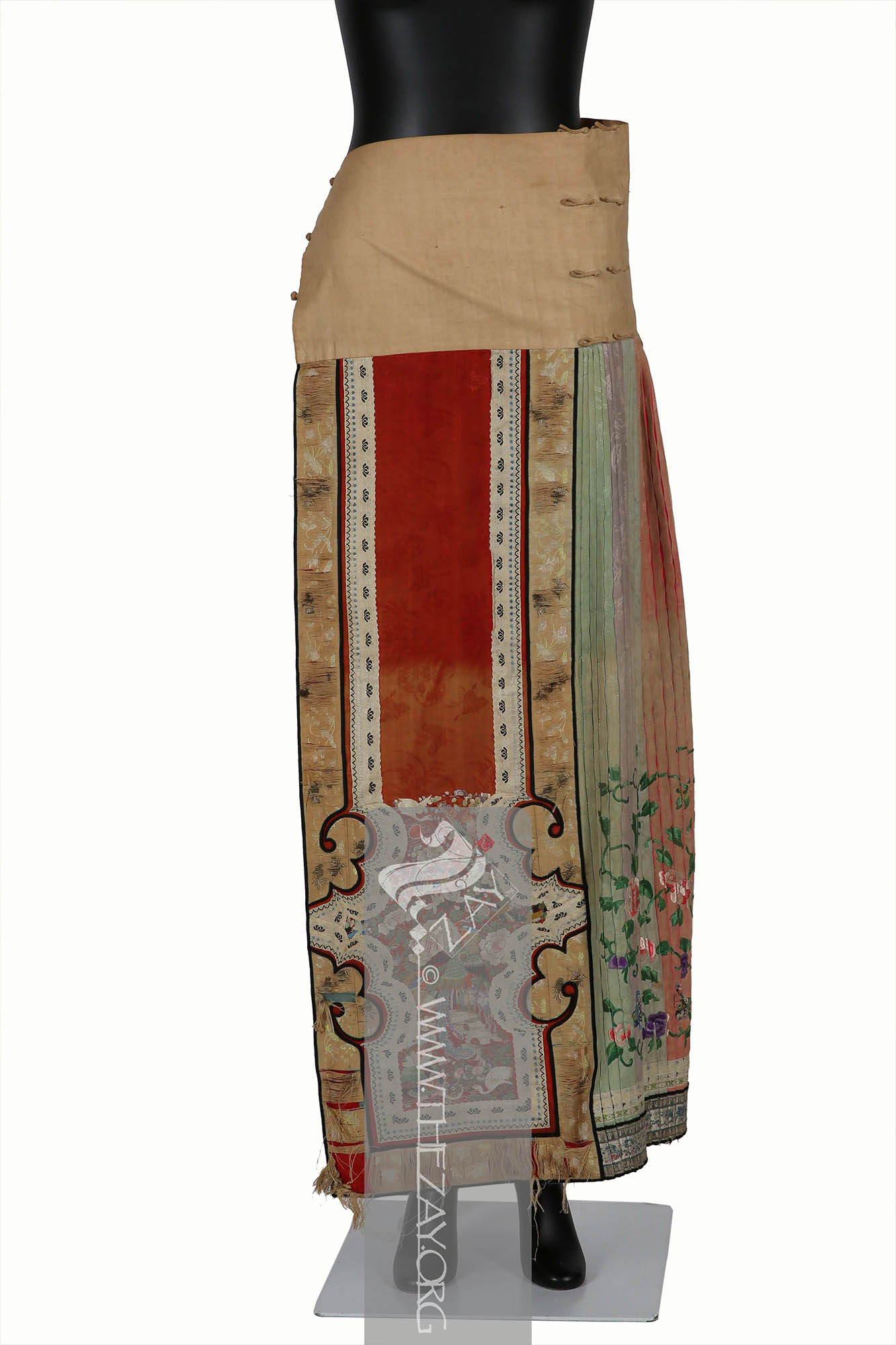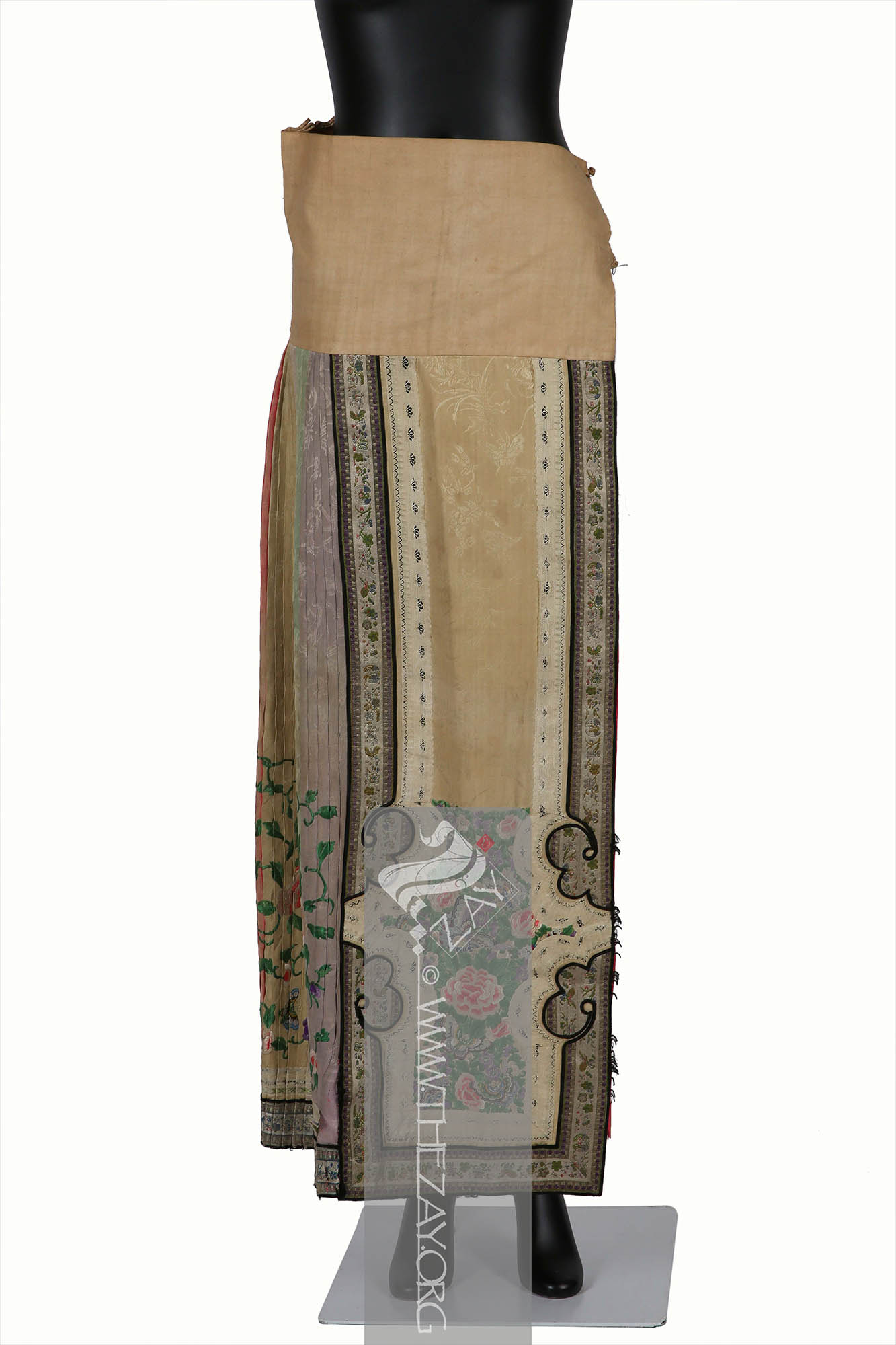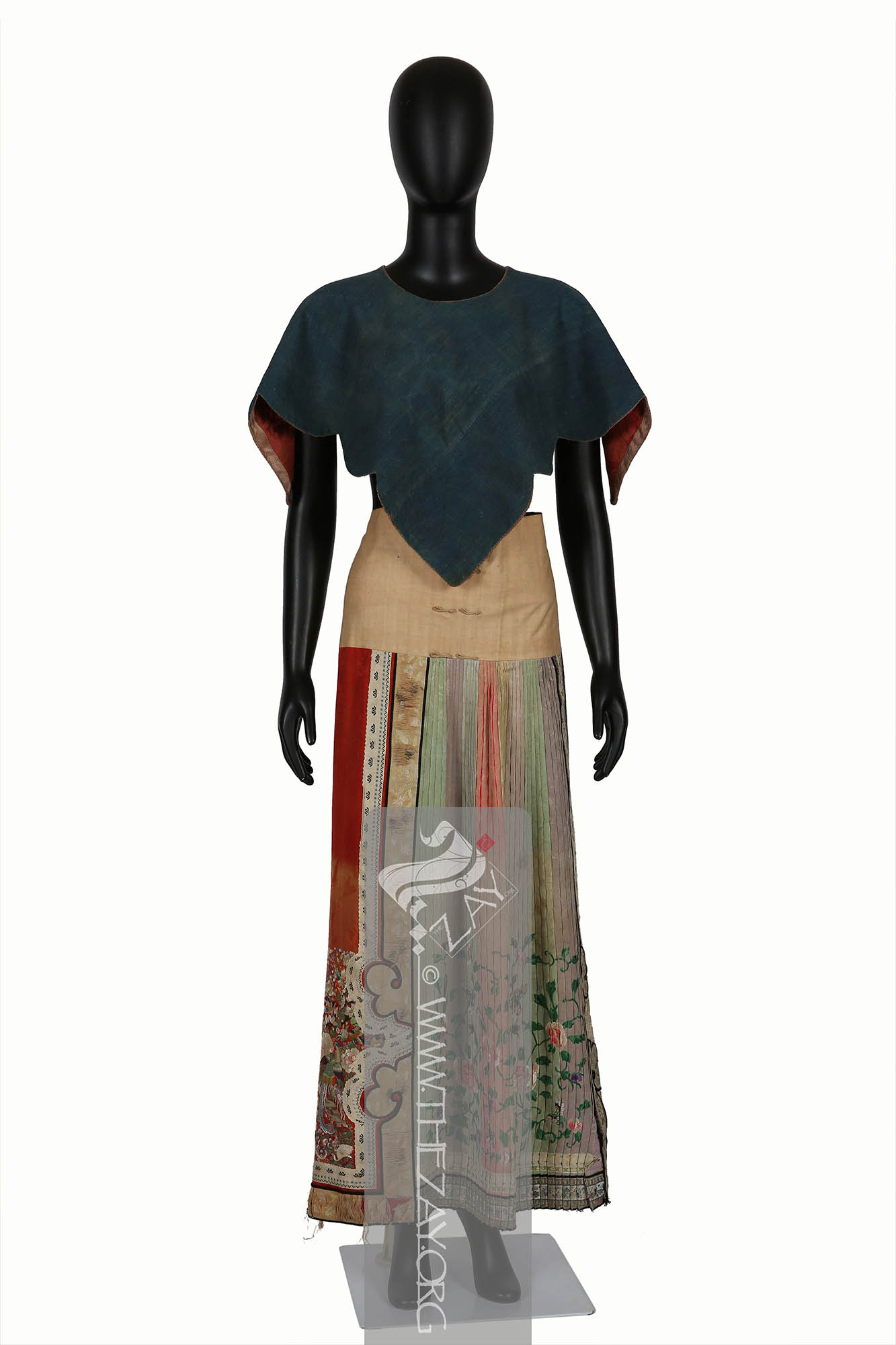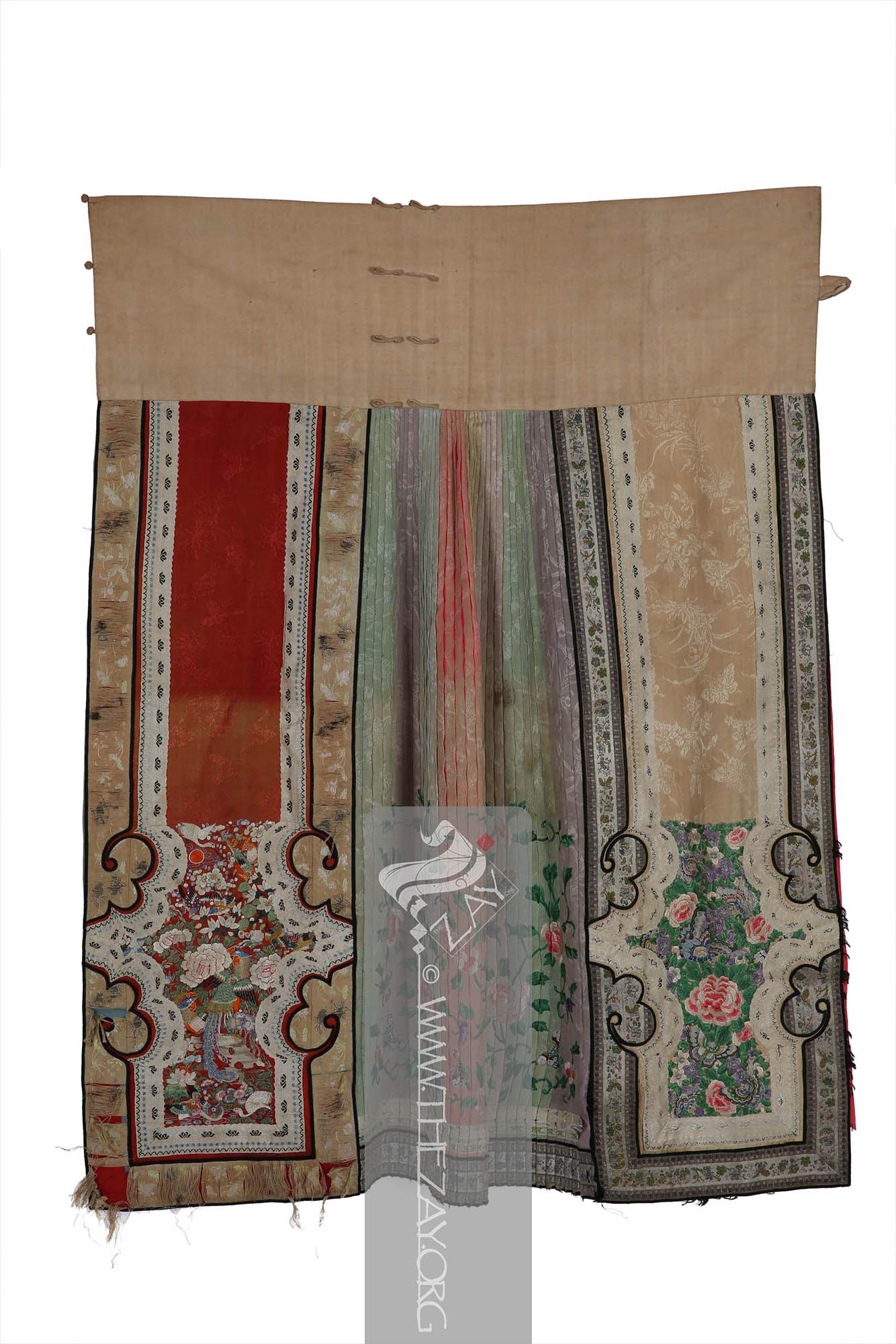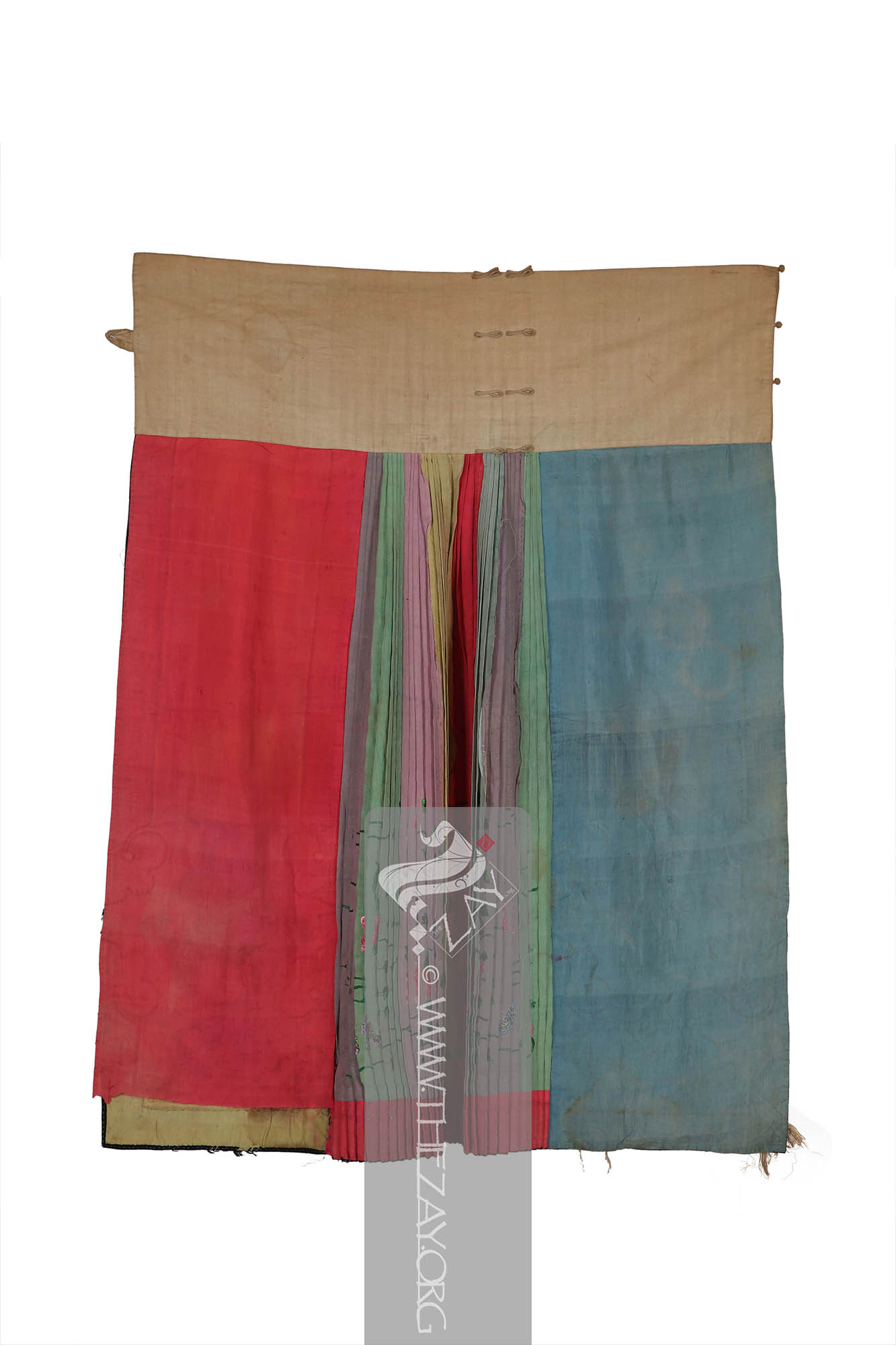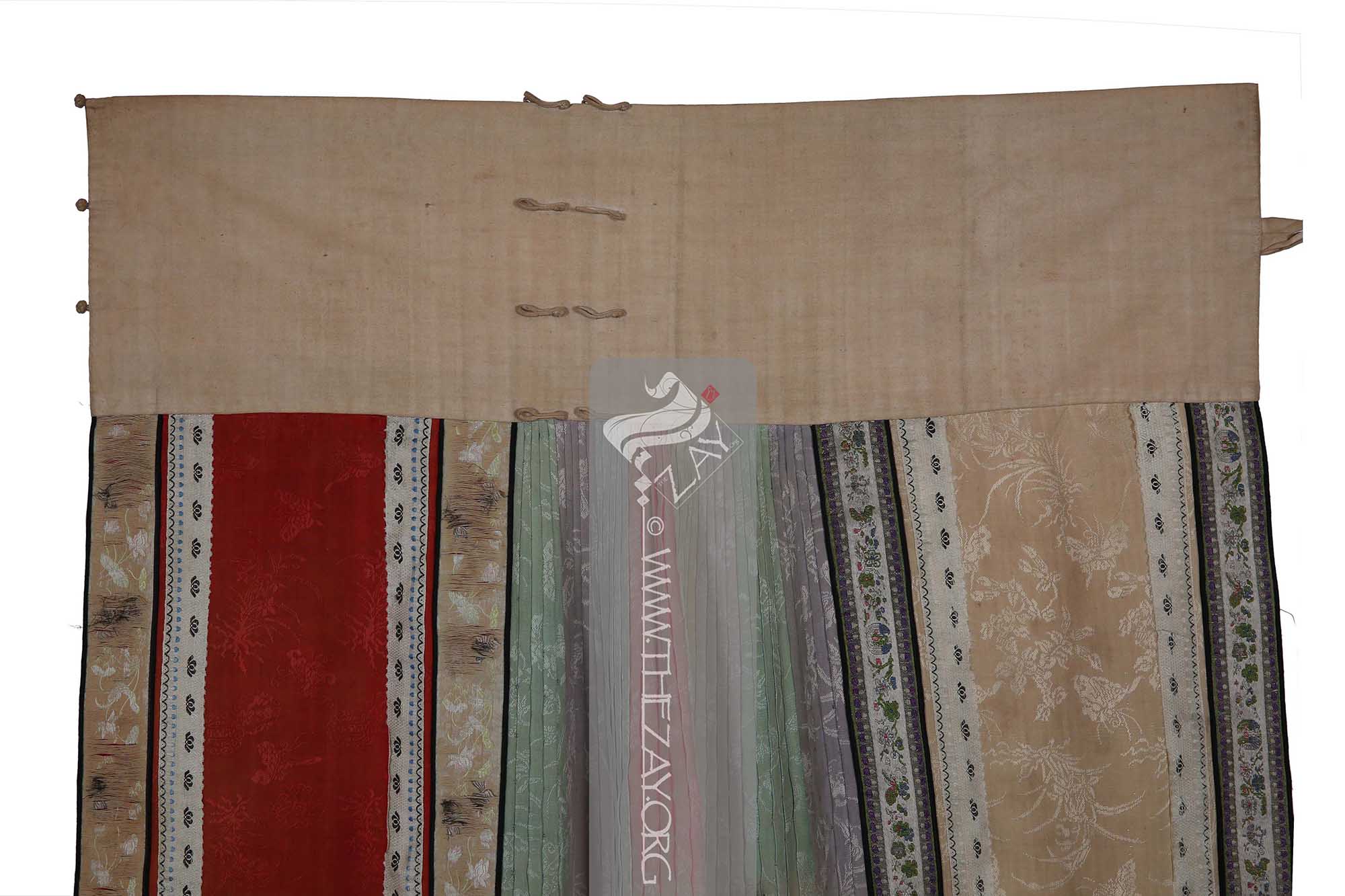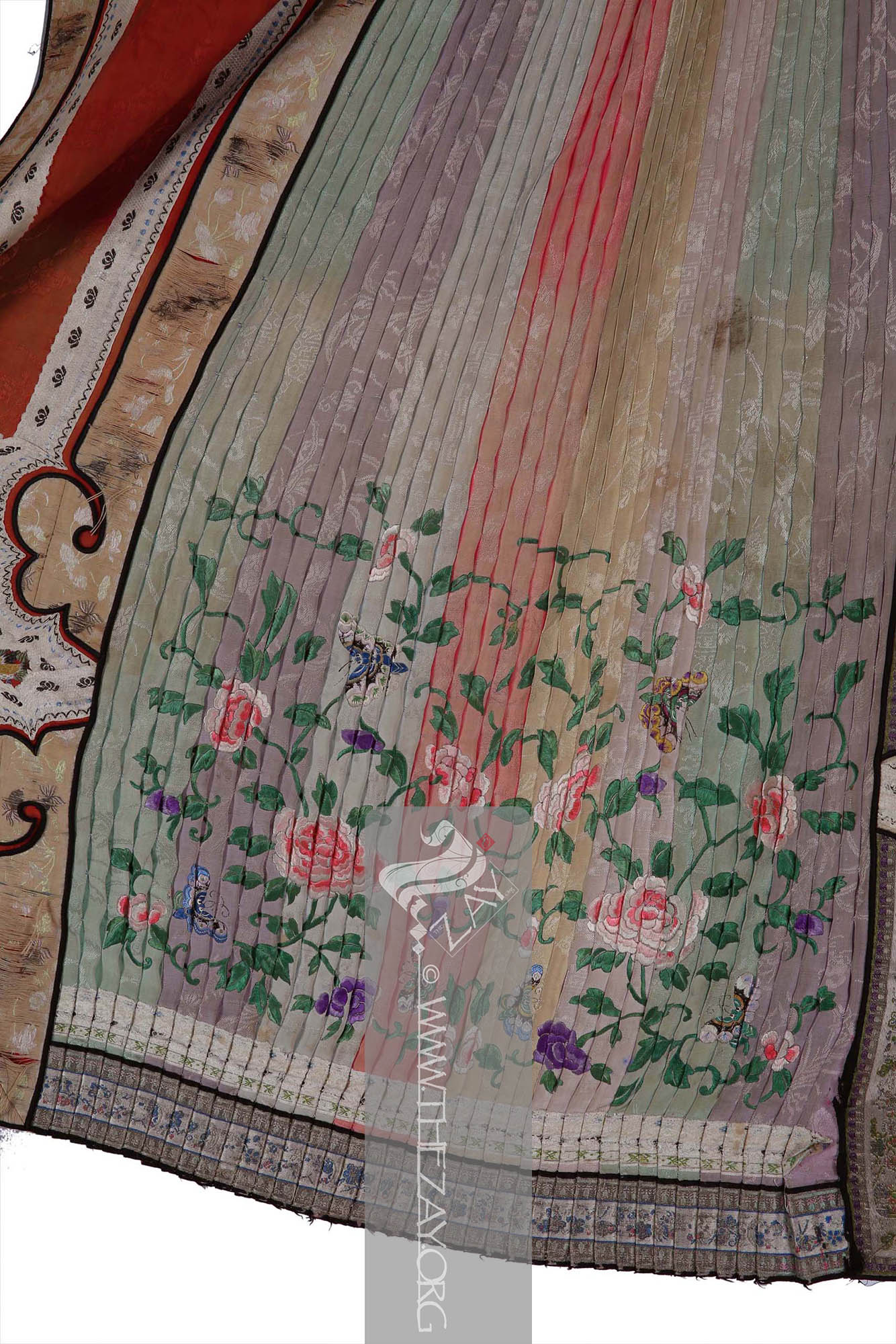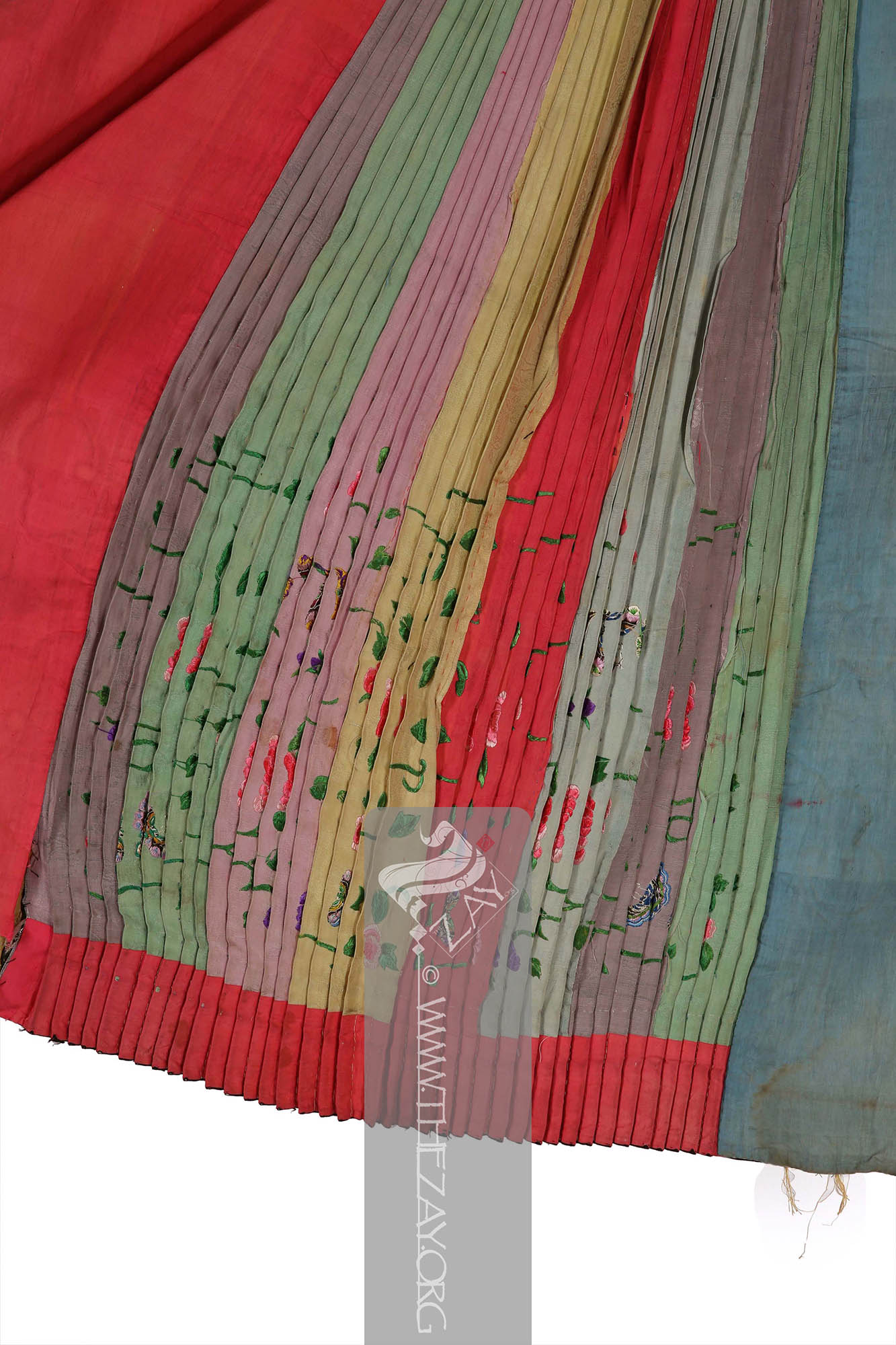Object NotePart of a two-piece ensemble along with a collar (
ZI2015.500847 ASIA).
Object HistoryThis silk and lace skirt with two pleated sides and a flat front and missing the rear panel, is a part of a type of horse face skirt (
mamianqun
Mamianqun: (Chinese: ma – horse; mian – face; qun – skirt; Synonym – Paired apron), is a lower garment item of women’s traditional Chinese ensemble. Possibly originated sometimes during the Song Dynasty (960-1279 CE), it is characterized by its series of fine pleats falling between three flat panels. ). It was purchased from a dealer in China by Dr. Reem El Mutwalli in 2015 and was incorporated into the
Zay
Zay: (Arabic: costume, Pl. azyaā’), a set of clothes in a style typical of a particular country or historical period. Initiative collections.
Object Features This delicate piece of panelled fabric is one half of a variation of a
mamianqun
Mamianqun: (Chinese: ma – horse; mian – face; qun – skirt; Synonym – Paired apron), is a lower garment item of women’s traditional Chinese ensemble. Possibly originated sometimes during the Song Dynasty (960-1279 CE), it is characterized by its series of fine pleats falling between three flat panels. – horse-faced skirt – called (
yulinqun
Yulinqun: (Chinese: yulin – fish scale; qun – skirt), is a variant of a mamianqun (horse face skirt) or paired apron. Possibly originated during the late Qing period in c. 19th century, it is characterized by four flat panels and two finely stitched pleated panels that create a honeycomb effect when stretched. ). The piece comprises three primary panels. The two side panels are plain (
satin
Sātin: (Arabic: Zaytuni: from Chinese port of Zayton in Quanzhou province where it was exported from and acquired by Arab merchants), one of the three basic types of woven fabric with a glossy top surface and a dull back. Originated in China and was fundamentally woven in silk.) (
damask
Dāmāsk: (Arabic: Damascus – a city in Syria), is a luxurious fabric woven with reversible patterns typically in silk, wool, linen, or cotton. Originating in China, the fabric was perhaps introduced to European traders at Damascus – a major trading post on the Silk Road with a thriving local silk industry. ) with (
appliqued
Appliqued: (French: appliquer – Apply), ornamental needlework where small pieces of decorative fabric are sewn on to a larger piece to form a pattern.) lace trimmings and embroidered designs while the central or middle panel is composed of seven different
satin
Sātin: (Arabic: Zaytuni: from Chinese port of Zayton in Quanzhou province where it was exported from and acquired by Arab merchants), one of the three basic types of woven fabric with a glossy top surface and a dull back. Originated in China and was fundamentally woven in silk. damask
Dāmāsk: (Arabic: Damascus – a city in Syria), is a luxurious fabric woven with reversible patterns typically in silk, wool, linen, or cotton. Originating in China, the fabric was perhaps introduced to European traders at Damascus – a major trading post on the Silk Road with a thriving local silk industry. fabrics in seven different colours intricately pleated.
Attached to an ivory linen broad waistband, this piece has (frog_fasteners) for wrapping it around the waist. The two side panels are both in
satin
Sātin: (Arabic: Zaytuni: from Chinese port of Zayton in Quanzhou province where it was exported from and acquired by Arab merchants), one of the three basic types of woven fabric with a glossy top surface and a dull back. Originated in China and was fundamentally woven in silk. damask
Dāmāsk: (Arabic: Damascus – a city in Syria), is a luxurious fabric woven with reversible patterns typically in silk, wool, linen, or cotton. Originating in China, the fabric was perhaps introduced to European traders at Damascus – a major trading post on the Silk Road with a thriving local silk industry. but in two different colours. While one flaunts an ivory panel the other flaunts a
coral
Coral: (Greek: korallion, probably from Hebrew: goral – small pebbles), is a pale to medium shade of pink with orange or peach undertones, resembling the colour of certain species of coral.. Both these panels are mirrored in design distribution. Both feature ivory cotton lace trimmings
appliqued
Appliqued: (French: appliquer – Apply), ornamental needlework where small pieces of decorative fabric are sewn on to a larger piece to form a pattern. to them primarily in a straight line except for the cloud formations on the sides. This is panelled or bordered off with a black
satin
Sātin: (Arabic: Zaytuni: from Chinese port of Zayton in Quanzhou province where it was exported from and acquired by Arab merchants), one of the three basic types of woven fabric with a glossy top surface and a dull back. Originated in China and was fundamentally woven in silk. fabric.
The ivory panel enjoys an extensive array of (
satin_stitch
Satin_stitch: (Synonym: Damask Stitch), is a type of flat embroidery stitch that creates a satin like smooth and shiny surface by closely spaced stitches, covering an entire area or shape.) embroidered floral arrangements of a central large peony in ivory and shades of pink with smaller peonies and other flowers in shades of lavender and foliage in shades of green. The
coral
Coral: (Greek: korallion, probably from Hebrew: goral – small pebbles), is a pale to medium shade of pink with orange or peach undertones, resembling the colour of certain species of coral. panel features an equally extensive array of stain_stitch embroidered aviary arrangements of a central phoenix surrounded by other birds like swallows, cranes, and ducks near a water body with floral and foliage motives in the background.
The central panel is constructed of seven different shades of
satin
Sātin: (Arabic: Zaytuni: from Chinese port of Zayton in Quanzhou province where it was exported from and acquired by Arab merchants), one of the three basic types of woven fabric with a glossy top surface and a dull back. Originated in China and was fundamentally woven in silk. damask
Dāmāsk: (Arabic: Damascus – a city in Syria), is a luxurious fabric woven with reversible patterns typically in silk, wool, linen, or cotton. Originating in China, the fabric was perhaps introduced to European traders at Damascus – a major trading post on the Silk Road with a thriving local silk industry. fabrics that are finely pleated and sewn by hand. These thin fine pleats are further secured by a series of alternate horizontal stitches and a series of (basting_stitches) on the underside. These series of multiple stitches give the skirt a fish scale or honeycomb effect when the fabric is manoeuvred by the wearer while walking. Thus, it is this fish scale effect what the skirt is named after.
It is believed that the name of the skirt is actually inspired by architecture, particularly by a type of squarish protrusion on a city wall that forms the base of towers or bastions. These protrusions are known as "ma-mian" or "horse faces" in Chinese because of their long, square shape. The skirt gets its cascading box shape from rolling pleats that fold inward towards the sides, creating a flat front and back with a slight flare from the sides. This shape bears a striking resemblance to the incline of Chinese fortifications.
Interestingly the
Yulinqun
Yulinqun: (Chinese: yulin – fish scale; qun – skirt), is a variant of a mamianqun (horse face skirt) or paired apron. Possibly originated during the late Qing period in c. 19th century, it is characterized by four flat panels and two finely stitched pleated panels that create a honeycomb effect when stretched. first made its appearance around c.19th century and gained popularity in the capital city of Beijing in c.1860s during the Tongzhi era.
This piece in the collection of the
Zay
Zay: (Arabic: costume, Pl. azyaā’), a set of clothes in a style typical of a particular country or historical period. Initiative is just one half of a skirt with the other half of the skirt a reflection of this piece in pattern and design whereby the pleated portions would fall along the side of the wearer.
With just a handful of countries earning mentions in the “Object range” section due to technical limitation, one must never forget the vast range of influence the Chinese culture have had throughout Southeast Asia. As such it would not be presumptuous to categorize all the countries of the region under this section where the
mamianqun
Mamianqun: (Chinese: ma – horse; mian – face; qun – skirt; Synonym – Paired apron), is a lower garment item of women’s traditional Chinese ensemble. Possibly originated sometimes during the Song Dynasty (960-1279 CE), it is characterized by its series of fine pleats falling between three flat panels. could have made an appearance in some form or another. Today the
Yulinqun
Yulinqun: (Chinese: yulin – fish scale; qun – skirt), is a variant of a mamianqun (horse face skirt) or paired apron. Possibly originated during the late Qing period in c. 19th century, it is characterized by four flat panels and two finely stitched pleated panels that create a honeycomb effect when stretched. with its characteristic of hundreds of tiny pleats continues to be popular, especially amongst the actors of the Peking opera.
In 2022 luxury fashion brand Dior was accused of cultural appropriation following the release of a black flared pleated midi skirt in their Fall collection of the year as their “hallmark silhouette”. Dior was accused of plagiarism because the new skirt was considered to be a replica of a traditional Chinese
mamianqun
Mamianqun: (Chinese: ma – horse; mian – face; qun – skirt; Synonym – Paired apron), is a lower garment item of women’s traditional Chinese ensemble. Possibly originated sometimes during the Song Dynasty (960-1279 CE), it is characterized by its series of fine pleats falling between three flat panels. , without any recognition of the potential Chinese influence on the design.
Links 




